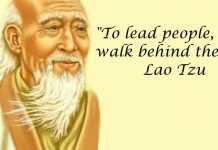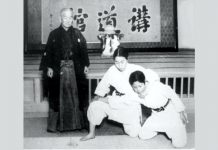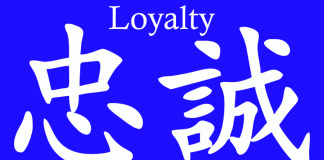Virtue is the fount whence honor springs. ~ Christopher Marlowe (1564-1593)
A salient feature of the samurai’s code of conduct was honor. Usually regarded as an abstract concept of respectability, it influenced both his social standing and his self-evaluation. It was, in fact, his good name, his reputation, ‘the immortal part of himself’. Any infringement on its integrity was considered shameful. The fear of disgrace was so great that it hung like Damocles’ sword over the head of every samurai and often assumed a morbid character. In the name of honour, many deeds were perpetrated early in life, in the belief that honor won in youth, would grow with age. At the least hint or imaginary affront the hot-tempered ones took immediate offence, and would resort to the use of the sword. Therefore much unnecessary trouble and danger was caused and many an innocent life was lost.
Dishonour took many forms. For example, only the samurai and family members were allowed to bear swords, usually daisho, one long and one short. Those who have read The Father of Judo will have noticed that both young Jigoro Kano and his elder brother are wearing hakama (worn over the kimono, tied at the waist and extending down to the ankles) and carrying swords in their childhood photograph. These are clear indications that both children were of samurai stock. When a samurai was out and about he took great care to prevent his scabbard accidentally touching another’s in passing in crowded locations. If one’s scabbard clashed with another’s, it was considered to be an unpardonable insult, and a sword fight to the death sometimes ensued. In September 1862, for instance, the Namamugi Incident (also known as the Kanagawa Incident or the Richardson Affair) occurred which was initially an indiscretion that quickly escalated into a major confrontation that later led to a short-lived war between the Satsuma clan of Kyushu and the British Navy. Although several conflicting accounts were given at the time with regard to the exact circumstances that transpired, from my research the details are as follows: four Britons, Charles Lennox Richardson, Woodthorpe Charles Clarke, William Marshall and Margaret Borradaile were out for a jaunt on horseback through the village of Namamugi (now part of Tsurumi ward, Yokohama) when they encountered a large procession of some 800 armed Satsuma clan retinue on their return journey from Edo (present-day Tokyo) to Kyushu. Instead of dismounting when repeatedly gestured to do so, Richardson in particular and his party were said to have ignored the request, or possibly did not understand the language or customs, for Richardson, in Japan for a short visit, was formerly a long-time resident of Shanghai, China. Their party apparently rode too close to the procession or perhaps impeded it, which resulted in all three men being viscously slashed for their alleged dishonourable attitude. Margaret Borradaile was also attacked, but luckily she narrowly escaped with her life. Being dressed in riding garb, it is possible that the assailants did not even realize that one of the riders was a woman. It should be mentioned here that samurai had a legal right to strike anyone who showed them disrespect. Later, Britain, which had in effect with Japan an extraterritorial treaty for British nationals, which meant that they were not subject to Japanese law, demanded reparations from both the government and from the Lord of Satsuma together with the arrest, trial and execution of the perpetrators. However, no trial ever took place. Satsuma prevaricated for a time before some low-ranked Satsuma samurai was named and executed for his alleged involvement in the murders. Following a British naval bombardment at Kagoshima, Kyushu, reparations were eventually paid by the Satsuma clan to the British government.
Around the 1860s, several treaties were concluded with Western governments and therefore foreigners were legally allowed to enter Japan under certain restrictions, such as to where they could live and trade and how far they were permitted to travel from home. There were, however, some groups in Japan who were violently opposed to relations with foreign governments and to the admission of foreign nationals. Many considered that the treaties Japan had been pressured to sign were in effect unequal treaties. Thus, foreign diplomats, merchants, seamen, academics, missionaries and others were sometimes attacked and either killed or severely wounded, often by bands of lawless ronin (masterless samurai).
One of the reasons for the frequency of these deplorable skirmishes was because legally they had the right to strike with sword anyone of lower class who compromised a samurai’s honour. This prerogative was known as ‘Kiri-sute gomen’. The right was defined partly as self-defense, and therefore the sword strike had to follow immediately after the offence had been committed. Thus, the striker could not attack someone for any past grievance. Also, due to the right of self-defense, it was not permissible for one to deliver a further coup de grâce. However, this was carried out in the case of Richardson after he fell from his horse, for the post-mortem report listed ten mortal wounds.
Because of the somewhat arbitrary nature of the samurai’s privilege, anyone who was on the receiving end of a samurai attack had the right to defend himself. This was most common in the case of a high-ranking samurai trying to forcefully exercise his authority over a lower-ranked one. Because of this situation, all lower classes, who were prohibited from bearing swords, naturally felt vulnerable against the samurai class and therefore they also wished to employ some method of self-defense by use of a weapon or some implement. Many took lessons in jujutsu and fashioned their working tools into weapons. For example, farmers would sharpen their sickles to razor sharpness, and attach implements, such as spiked metal balls and chains to further reinforce the effectiveness of the sickle. The art of jojutsu (stick fighting) came into vogue since the long staff, when used skillfully, was a reliable mode of defense and offense against an assailant armed with a dagger or a sword. This state of affairs has some parallels to today’s terrorist incidents in the West whereby terrorists sometimes use weapons camouflaged as ordinary everyday utensils.
The body of laws to which all regular samurai had to obey included harsh punishments for any infringements by transgressors; these included apprehension, torture and death. It was a society with the necessary structures in place that required it to enact and enforce laws. Nevertheless, at the same time, samurai were taught and indeed urged to be compassionate as well as brave. In character, samurai were ideally considered to be gentlemen, and gentlemen were considered to be samurai. But in reality many were not. There were comparisons with the then codes and practices of European knights of the period. However, one of the samurai’s distinguishing characteristics was that whereas in Europe many knights were totally illiterate brutes, some basic education was sought and deemed a desirable acquirement by many of the samurai. My understanding here is that this was probably because of the influence of the philosopher and strategist Yamaga Soko (1622-1685) who wrote Bukyo ‘the warriors’ creed’ and Shido ‘the way of the gentleman.’ He put forward the mission of warriors and their obligations. It was he who reasoned that whereas farmers, artisans and merchants played useful key roles in society, the samurai, in the absence of war, played no useful role at all. The samurai, besides the right to bear swords, had a certain number of other rights, for instance, they received stipends of food and cash, paid no taxes, no tolls, had the right to wear hakama, and to ride horses. They did in fact live off the toil of the rest of society. Yamaga therefore favoured and applied the Confucian idea of the ‘superior man’ to the samurai class and this later became an important part of their way of life and code of conduct. In his treatise, Yamaga urged samurai to devote themselves to educational and cultural pursuits. He emphasized that the peaceful arts of letters and history were essential to the intellectual discipline of the samurai. This had the desired outcome on society for it transformed the samurai class from a purely military aristocracy to one of increasing political and intellectual leadership. As indicated in Judo Memoirs of Jigoro Kano it tended to alleviate to some extent much of their intense brutality. Many of them thus became, much later, a progressively potent force in the modernization of Japan after the samurai system was abolished in 1876 and the carrying of swords banned.
Strange as Yamaga’s influence may seem, there were occasional reports of a samurai, condemned to commit ritual suicide because of some dishonorable act, would first compose a death poem before ending his life. According to Bushido, the upholding of honour was seen as a duty by the samurai. When one lost honour, the way to save one’s dignity was death. Seppuku was the most honourable death in such a situation. The only way for a samurai to die more honorably, was for him to be killed in battle. This resurrected principle explains the kamikaze exploits carried out by Japanese fighter pilots and other military men in World War II. Before the feudal system was abolished in 1876, however, there were estimated to be some 450,000 samurai plus their family members, which increased the number to some 2 million out of a total population of some 30 million. In character they reportedly included in their ranks every grade of culture from the consummate gentleman and noble patriots, to those, some of them ronin, of whom it was said were lewd bullies and vile ruffians who killed without mercy.
Moving on to more recent times, the concept of honour in most sports appears to have declined in importance in the West. Be that as it may, in judo competitions, cases of contestants committing a deliberate, serious offence leading to disqualification are rare. An example of reportedly genuine praiseworthy conduct took place during the 1984 Los Angeles Olympic Games Open Weight final match. The Egyptian heavyweight Mohamed Ali Rashwan recalled that the man to beat on that occasion was Yasuhiro Yamashita. Rashwan said that he was dreaming of meeting him in the final. He also added that, should he face Yamashita in competition, he would make every effort to dethrone him. As it so happened, Rashwan did in fact meet Yamashita in the final match.
In a previous bout, however, Yamashita had suffered a torn calf muscle, a most debilitating injury. He was therefore very much incapacitated as to the techniques he could hope to use. Rashwan knew full well the extent of his injury as he eyed Yamashita limping onto the mat to face him. According to Rashwan, he did not wish to win by attacking Yamashita’s injured leg, because if he did so, people would declare, “You won because Yamashita was injured.” Rashwan, therefore, refrained from such an attack and instead attempted a hip throw during the early part of the ensuing bout in which both stumbled and fell to the mat where Yamashita managed to secure a hold down on Rashwan and so won the Olympic gold medal. Rashwan later said that he was disappointed at his loss, but happy for Yamashita.
Rashwan’s conduct had an exemplary dimension, for a year later; he was informed by the IJF (International Judo Federation) that he had been awarded the ‘Medal of Fair Play’ for his honourable actions in the final match of the 1984 Olympic Games Open Weight Category. Rashwan said he felt very proud to have received such recognition. He explained to the younger generation that the most important thing is to respect each other. “Sport”, he said, “has too often become like war. We must return to the core values of sport, an athlete must respect his or her opponent, students must respect their masters, and referees must respect the competitors and vice versa.”
An emphasis on the importance of honour exists in such traditional institutions as the military, the police force and in other organizations with a military ethos, such as firefighters, boy scouts and girl guides. In this regard, I should mention here that a number of Kano’s students who joined military ranks lost their lives in warfare during the early years of the Kodokan. One in particular who saw military action during both the Sino-Japanese War (1894-1895) and the Russo-Japanese War (1904-1905), was Hirose Takeo. Commander of the Fukui-Maru, Takeo was killed by enemy cannon fire as he desperately made a third heroic attempt to rescue his warrant officer, Sugino, during the height of battle at Port Arthur. He was aged 57 at the time of death, following which professor Kano awarded him a 6th dan judo grade posthumously on April 8, 1904.
A loss of honour or loss of face as it is often called is prevalent in some cultures, particularly so in Asia, by which a family member who has committed a crime or somehow brought disgrace on the family name is shamed. The offender is often punished physically or psychologically. The use of violence is sometimes collective in character whereby relatives act together. The most extreme form of punishment is, of course, honour killing. When vengeance is at the family level it can result in a long-term sustained feud between families. What sometimes happens in Japan in the case of say one’s grown up adult son who has been found guilty of a serious crime; the father is the one who commits suicide in the belief that he should accept responsibility for his son’s actions because if he had carried out his duty correctly in the raising of his son, his son would not have committed the crime.
The highest honors recognized by the state are those who receive medals and monetary awards for outstanding achievements, be that bravery in wartime, in the case of the United Kingdom, for example, the awarding of the VC to a military man (Victoria Cross) or bravery by a civilian, in the case of the GC (George Cross). In the world of academia the most illustrious decorations are, without doubt, the Nobel Prizes, two of which have been awarded to Kodokan black belt holders: Professor Ryoji Noyori, a 1st dan, past president (2003-2015) of RIKEN Physical and Chemical Research Institute, who achieved the 2001 Nobel Prize for Chemistry, and medical researcher Professor Shinya Yamanaka, of 2nd dan grade, who gained the 2012 Nobel Prize for Medicine.
Brian N. Watson
Tokyo, Japan
March 8, 2018
References:
The Father of Judo, B.N. Watson, Kodansha International, 2000, 2012
IL Padre Del Judo, (Italian) B.N. Watson, Edizioni Mediterranee, 2005
Judo Memoirs of Jigoro Kano, B.N. Watson, Trafford Publishing, 2008, 2014
Memorias de Jigoro Kano, (Portuguese) B.N. Watson, Editora Cultrix, 2011
Saving Japan’s Martial Arts, Christopher M. Clarke, Canyon Press, 2011
100 Years of Judo in Great Britain, Vol. 1, by Richard Bowen, IndePenPress, 2011






